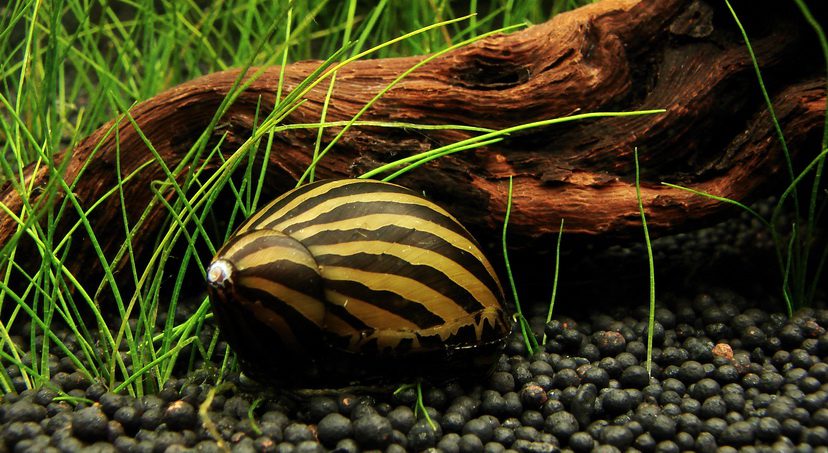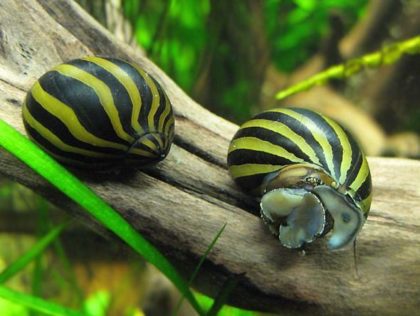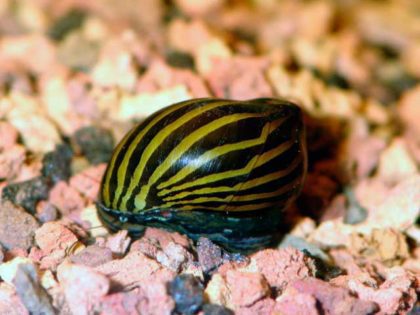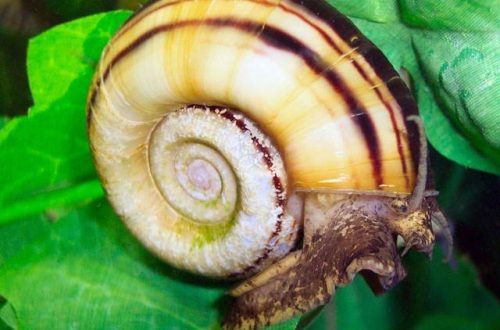
Neretina: content reproduction, description, photo, compatibility

Neretina snails have become increasingly popular among aquarists. This species belongs to freshwater snails, although some representatives of this species live in sea water. Neretina owes its popularity to the fact that it perfectly removes all unnecessary pollution in the aquarium. She also has no equal in eating algae. Nowadays, the following varieties of this snail can be most often found:
- Olive Nerite Snail
- Neretina zebra (Zebra Nerite Snail)
- Tiger Nerite Snail
- Horned Nerite Snail
And every day there are more and more varieties that are popular, while the differences between them are only in appearance: neretina O-ring, neretina beeline, solar neretina, and also red-dotted neretina.
Contents
Content in an aquarium
There is nothing easier than keeping Neretin snails at home and caring for them. Anyone can handle this. They do not require special care, the only thing you need to remember is that these are tropical snails, and that is why they need hard water, they do not like soft water because of the impossibility of forming a shell in it. In water of normal hardness, they have no problems with this. In addition, the water temperature should be at least 24 degrees.
The owners of these snails should definitely watch how much nitrate and ammonia are in the water, as they do not tolerate them very well. It must be remembered that every week you need to change up to one third of the water in the aquarium to fresh. It is also important not to forget that if aquarium fish are sick, they should not be treated with preparations containing copper, to which neretins are sensitive.
When you lower the Neretina into the aquarium, you need to take into account the fact that in no case should you just throw it into the water, but lower the snail to the bottom with gentle movements. Otherwise, she may die, as she is not too adapted to turning over on her own.
It is also important that there are enough plants in the aquarium in which you lower the Neretina. This is necessary so that at the very beginning of the aquarium life, neretins can eat parts of plants that rot. In addition, she will also eat algae.

Neretin is usually kept only with peaceful ak fish, as well as with invertebrates. There are absolutely no problems from the Neretina itself. But it can easily suffer, and primarily from large fish or fish that feed on snails.
What does neritin look like?
Its shell is large, massive, has the shape of a drop.
The operculum (this is a kind of lid or “hatch” that completely or partially closes the hole in the shell) is small, not located in the center and grows only on one side, not on all sides.
The head and legs are oval, the mouth is round. Antennae filiform. The eyes are located on small irregularities.
The body is most often gray in color, while the head and mantle are black or brownish-gray with speckles. The body is almost completely covered by the shell.
The average size of neritina depends on its species and is approximately 2 cm. The zebra and tiger varieties are slightly larger, which grow up to 2,5 cm.
The shells of these mollusks can be colored very differently, and there are simply no two snails with the same pattern. Black, dark brown, dark green, olive and even red-orange individuals are known. Their covers are decorated with a pattern of stripes, spots, dots, strokes, and the shell itself may have outgrowths or horns.
These snails do not live long: one, maximum two years. Very often they die immediately after being placed in a new aquarium or after a week. This is due to hypothermia during transportation, or a sharp change in conditions of detention.
A dead snail decomposes quickly, spoils the water very badly and smells bad in the aquarium. For this reason, we advise you to regularly check your home pond and remove the dead in a timely manner.
Snail color and lifespan.
Neretins live on average for about a year. Common reasons for the death of this mollusk are a sharp change in living conditions, and hypothermia during its delivery from the store home.
The length of the Neretina can reach 2.5 cm, and the color is the most diverse: from black to green with stripes, dots and spots of various shapes.
Shellfish feeding.
Neretins are the best destroyers of all kinds of algae. These active snails are in constant motion, leaving a clean trail behind them. Shellfish do not harm aquarium plants, but they cannot get rid of all algae. Since algae appear as a result of an imbalance in the aquarium, this problem must be addressed in the first place.
In addition to their favorite food, Neretins should be given cereals and an algae called spirulina. During the consumption of food, the snail constantly crawls from place to place, and then it can freeze for a long time. Do not panic ahead of time thinking that your pet is dead. You need to smell the Neretina, because the dead snail has an unpleasant odor.
Varieties of neritin
The following species are most often kept in aquariums:
Beeline (Clithon corona). They were imported from China and from the Philippine Islands. These are medium-sized snails with a size of only 1-1,2 cm.
“Tiger” (Neritina turrita). Came to us from Southeast Asia. Quite large, grow up to 2-2,5 cm. The shell is rounded. It is surrounded by dark orange or light brown stripes. Dark (black or brown) lines are clearly visible at the top. The pattern of each individual is individual, and all the stripes are of different thicknesses.
“Zebra” (Neritina natalensis zebra). Distributed in Kenya, South Africa and throughout the territory between them. They inhabit mangrove swamps and lagoons. These are giants among neretins, growing up to 2,5-3,5 cm. Their body is painted in greenish-yellow or yellowish-brown tones. Against this background are wide black stripes in the form of zigzags or slanted lines. In the anterior part of the shell, the dark stripes thin out, and there are more yellow areas. The tone of the body is grayish or reddish-yellow. It was noted that runaways from aquariums among the “zebras” are the most common.
Red-dotted, ring-striped (Neritina natalensis). They were brought from Indonesia and from Sulawesi. The size is similar to the previous type. They are very fond of warm water (28-30 ° C), they cannot stand the presence of copper in water and react negatively to acidity below 7 (their shell breaks up and they die). Their carapaces are mahogany-colored and covered with black spots.
Olive (Olive Nerite Snail). Strange, but there is practically no information about it, only general questions of content. (Horned Nerite Snail). They are found in countries such as Japan, Thailand, China, Indonesia and the Philippines. They prefer lagoons and mouths of small rivers, the bottom of which is rocky or sandy. She was nicknamed Horned because of the growths on the sink. These spikes are very similar to horns. In each individual, these horns are located differently. Sometimes they are broken off, but this does not affect the health and well-being of the snail.
Growths are protection from enemies, since their injection is quite noticeable. The shell is covered with alternating yellow-olive and black stripes. These mollusks do not grow large, only up to 1-2 cm. They live from 2 to 5 years. They don’t get out of the water. If this still happened, it means that they are not satisfied with the conditions that need to be corrected.
The nature and compatibility of neritin
Neighborhood with
- macrobrachiums (shrimp),
- number,
- crabs,
- predatory helena snails,
- cichlids,
- macrognathusami,
- botsii,
- macropods,
- tetraodonami,
- large catfish such as Clarius,
- roosters, etc.
With whom can they be kept? With all the friendly fish and invertebrates. These snails themselves are very peaceful and do not disturb the rest of the inhabitants of the aquarium.
Snail breeding
Neretins are not hermaphrodites, snails need individuals of both sexes to reproduce, but it is very difficult to determine their gender. These gastropods are not bred in fresh water, even the use of sea water can rarely lead to a positive result.
For the appearance of offspring, snails should create conditions similar to their natural habitat. But, despite this, the Neretin snail still continues to lay eggs on the ground, plants and various hard surfaces. Since there are many eggs in the clutch, and they are hard white dots, this spoils the aesthetic appearance of the aquarium.
In order for the snails to stop their fruitless attempts to breed, you just need to add a few relatives to them. This has a calming effect on the mollusks, that they no longer need to take care of procreation, but can safely enjoy life.
As a result, when purchasing neretin for an aquarium, you need to be ready for decor in the form of white peas. But omitting this drawback, this snail is perfect for the role of a beloved pet.
How to run neritin in an aquarium
It will be better if the aquatic environment in the aquarium is already settled and balanced.
In such a reservoir, the water parameters are stable, so the snails adapt faster. There are a lot of plants here, and therefore, rotting remains that will give food to the Neretins at the initial stage.
There is a lot in it and the main food of these mollusks – algae.
It is important to properly launch snails into the aquarium. Do not throw at random, but turn it over to the correct position and gently lower it into the water.
If at least one individual falls upside down, then it will not be able to roll over on its own and will die.
What to look for when buying neritin
- It is necessary to carefully inspect the sink for cracks and other damage.
- If possible, then observe the behavior of snails. It is better not to take specimens lying at the bottom.
- Be sure to look inside the sink. No matter how ridiculous it may sound, there are known cases of buying empty shells.
Let’s summarize. The Neretina snail for an aquarium is perfect for everyone: it is beautiful, it is an unsurpassed cleaner, it does not harm plants and other inhabitants of the aquarium, it is not difficult to acquire it, it is easy to care for it, it will not burden you with unwanted offspring. The only drawback is that they spoil the appearance of the egg laying, but this is also quite easy to fix.





